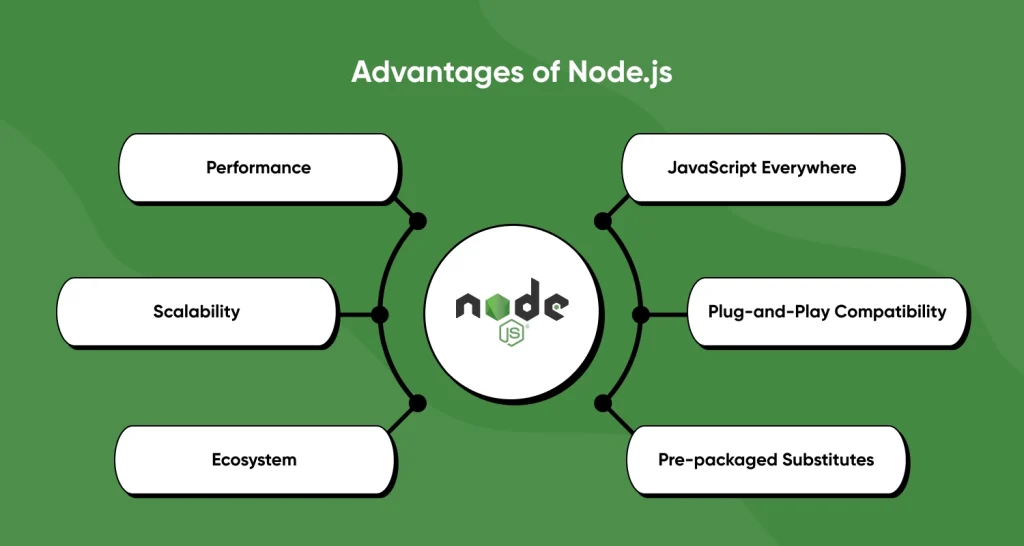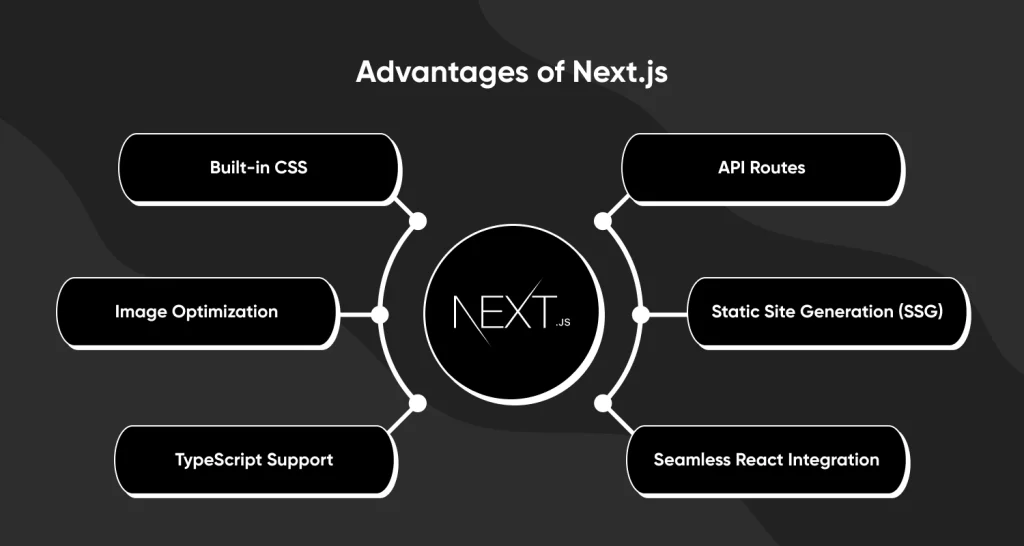Are you considering using a reliable JavaScript application development tool? To help you sort through all of the alternatives, it’s important to compare Node JS vs Next JS. When you compare Next JS vs. Node JS, you compare a feature-rich React framework with a stable JavaScript runtime.
These are two of the most widely used frameworks for efficient development. Whether you want an SEO-optimized website or a server-heavy application will determine which tool is best for you. We explore the Next.js vs. Node.js debate in this blog and offer a thorough analysis.
Let us first understand each of the tech stacks.
What is Node.js?
Among backend developers, Node.js has made a name for itself as a runtime environment for JavaScript that allows code to run outside of a browser, which is useful when creating server-side apps and APIs. Node.js works well in situations requiring an API and support for asynchronous processing because it is built for more complicated jobs.
Hire Node.js developers who are skilled in using APIs to create modular apps with independently deployable features using Node.js’s support for a microservices-based architecture. Its single-threaded, however, could cause crashes or performance snags in programs that require a lot of computing power.
The Architecture of Node.js
Examining Node.js’s design indicates that it uses an event-driven paradigm of operation. The EventEmitter module allows objects to emit and listen to events, including HTTP requests, responses, and Node.js streams. The mechanism via which Node.js’s Emitter objects issue named events and listener functions react to them is essential to the non-blocking I/O paradigm that Node.js offers.
SetImmediate() and process.nextTick() can be used to further control operations asynchronously, delaying execution and correctly sequencing events. Multiple listeners for the same event are possible using Node.js best practices and an event-driven approach, which makes scalable and extendable systems possible. Additionally, the EventEmitter module offers effective listener management features.
Advantages of Node.js

- Performance: Node.js’s non-blocking input/output model enables it to manage numerous connections at once without being slowed down by conventional blocking processes.
- Scalability: Node.js’s event-driven architecture and minimal weight make it an excellent choice for developing real-time apps and microservices that can withstand high traffic volumes.
- Ecosystem: Express.js, one of the many tools and frameworks that make up Node.js’s vast ecosystem, makes web application development easier.
- JavaScript Everywhere: Node.js enables developers to leverage JavaScript on the client and server sides, promoting code reuse and increasing efficiency.
- Plug-and-play Compatibility: Node.js’s plug-and-play compatibility helps build applications more quickly and efficiently. Its architecture, which only uses one thread, further improves this.
- Pre-packaged Substitutes: To further cut costs associated with development, Node.js boasts a robust package management framework with numerous open-supply substitutes.
Drawbacks of Node.js
Although there are numerous advantages to this style, there are also disadvantages. While deciding between the two frameworks, bear in mind the following few drawbacks of each.
- Performance Bottleneck: Node.js’s single-threaded loop architecture makes developmental tasks that demand a lot of CPU power more difficult. Because Node.js processes all requests on a single thread, a significant amount of processing power is needed, which interferes with other operations and degrades performance.
- Reduced Capability to Process Information: The reduced processing capacity of Node.js’s single-thread design is another disadvantage. This reduces the productivity of the development process and affects the application’s efficiency.
- Adaptability Challenges: Node.js does not fully enable vertical scalability, despite its prowess in managing concurrent connections. The creators are unable to fully utilize the advantages and capabilities of multi-core CPUs due to their single-thread architecture.
Companies that Use Node.js
- Netflix
- Uber
- Trello
- GoDaddy
- PayPal
- Groupon
- Walmart
- Citibank
What is Next.js?
On the other hand, Next.js is a React framework made to make online apps and webpages more quickly, interactive, and user-friendly. Next.js minifies browser bundles and generates JavaScript for the best possible performance and compatibility with contemporary browsers. The “next build” command, which creates an optimized version of the production application, makes the deployment of your application easier.
Additionally, hire Next.js developers from a well-known development company who can offer a range of deployment methods that let projects begin as Single-Page Applications (SPAs) or static websites and grow to incorporate server-side functionality. Because of these features, Next.js is an extremely effective tool for web development, particularly when it comes to building user-friendly, SEO-optimized web applications.
Using Server-Side Rendering to Improve SEO
The ability of Next.js to improve SEO through server-side rendering and static site generation makes it stand out in particular. The generation of fully rendered HTML either at build time or at request time improves dynamic content’s indexability by search engines, a crucial aspect of search engine optimization.
Additionally, Next.js’s static site generation generates HTML pages throughout the build process, guaranteeing that all information is available when the website loads. This enhances page performance, a crucial component of search engine ranking, and helps SEO. By customizing the rendering approach for each type of content-for example, employing server-side rendering for dynamic material like news feeds and static site creation for static content like blog posts—developers can maximize search engine optimization.
Advantages of Next.js

- Built-in CSS: CSS data may be imported from a JS source with ease when utilizing Next.js. This drastically cuts down on overwriting and speeds up the coding process.
- Image Optimization: The most recent iteration of Next.js offers consumers automatic picture optimization along with all of its components. Using route segments to facilitate automatic code splitting is just another fantastic feature of Next.js.
- TypeScript Support: Excellent TypeScript support is provided by Next.js, enabling developers to write type-safe code, identify problems early, and enhance code maintainability.
- API Routes: Next.js makes it simple to develop backend functionality within the same project, which lowers overhead and streamlines deployment. It does this by enabling you to define API routes alongside your pages.
- Static Site Generation (SSG): Next.js allows developers to create static sites during the construction process, which lowers server load and speeds up page loads.
- Seamless React Integration: The seamless integration of Next.js with React enables developers to add server-side rendering capabilities while harnessing the full power of the React ecosystem.
Disadvantages of Next.js
- Limited Possibilities for Routing: Basic page-based routing options are used by Next.js; these are useful for developing small apps but require a lot more code for more complex ones.
- Rigid Structure: Because Next.js is a rigorous framework, developers are limited in their ability to innovate creatively when incorporating features.
- High Level of Expertise Needed: An extension of the popular javascript framework React is called Next.js. To code in the language, highly qualified and experienced programmers are required.
Companies that Used Next.js
- Nike
- Github
- Deliveroo
- Binance
Comparing the Essential Features of Next.js with Node.js
When we look at Node.js and Next.js, we can see that they have different purposes and functions. While Next.js is a React framework with server-side rendering capabilities, Node.js is a runtime environment for server-side JavaScript execution.
Next.js takes advantage of its status as a framework to provide a full suite of capabilities for server-side and static rendering in React apps, whereas Node.js is mostly used as a runtime environment. Node.js provides development freedom by enabling solitary adjustments that impact a single node, all without requiring changes to the main program infrastructure.

What is the Difference Between Node.js and Next.js?
Both are top-notch Javascript development frameworks that function at various stages of the web development stack. They are employed in projects of various sizes and have various functions. These are the main differences between the two popular web development technologies, Next.js and Node.js.
Scope
Notch.JavaScript code can be run on the server side with js. It offers a platform for developing several kinds of server-side applications, such as command-line tools, web servers, APIs, and microservices.
Next.js, on the other hand, server-side rendered (SSR) and statically generated (SSG) web applications are mostly constructed with the js React framework. It is specially made for using React to create client-side web applications. React provides further optimizations and built-in support for server-side rendering.
Functionality
Javascript code in Node.js is run independently of the web browser that Node.js provides. It has capabilities for handling input/output (I/O) operations, such as file access, network queries, and event-driven programming through the use of the Node.js event loop.
However, Next.js expands on the features of Node.js and React to facilitate the creation of web applications. It contains features like TypeScript compatibility, server-side rendering, automated code splitting, and routing.
Application
Node.js Many tasks, such as server-side scripting, API development, backend development, and creating command-line tools, need the use of JavaScript.
Next.js has additional server-side rendering features, js is mostly used for client-side web applications. Building websites and online apps that are optimized for search engines and performance is more practical.
Developmental Framework
Additionally, the two frameworks can operate differently on the server to manage client requests, conduct data processing, and provide responses. Next.js offers a hybrid development paradigm by fusing JavaScript execution on the client side with server-side rendering. With this specific paradigm, developers can render React components on the server side before running the code.
On the contrary, Node.js is a runtime for JavaScript. It is a server-side code execution environment that offers a comprehensive platform/environment for server-side JavaScript execution.
File Structure and Code Organization
In terms of file structure and code organization, Next.js differs from Node.js. It has pre-established code folders and rules. It uses components and handles the most basic stylesheets, routes, and assets.
Since Node.js is a runtime environment, it lacks this kind of pre-established code organization structure, allowing developers more freedom to customize the application to their specifications.
Selecting the Best: Node.js vs. Next.js Framework
Compared to Node.js, Next JS is a relatively new framework. These are some additional tips to assist you decide between Next.js or Node.js in the dilemma.
If you want to create basic or complex server-rendered React components, static React webpages, or SSR applications, Next.js is a good choice.
Additionally, it is a superior choice when creating dynamic, SEO-friendly websites with a significant emphasis on user interface design.
However, Node.js is the only choice for development when:
- Applications in real time must be developed.
- Microservices architecture is needed for the development project because Node.js is flexible enough for this specific model.
- Constructing GraphQL endpoints or RESTful APIs. When used with other web development frameworks like Express.js, Node.js provides a potent combo.
After thoroughly examining the needs and characteristics of the project, a reputable Node JS development company or Next JS development company can assist users in making the best choice. It is also possible to integrate Node.js and Next.js with many other programming tools.
Conclusion
While these two frameworks/runtimes have several alternatives, Next.js and Node.js are the recommended choices due to their numerous noteworthy USPs.
In the end, for web development, both the framework and the runtime provide excellent tools and solutions. The choice between the two depends on several variables, including size, functionality, desired features from the developers, and more.
While many development firms provide these services, only a select handful rise to the challenge of providing reliable services. On the other hand, NextJS and Node.js development services company, CMARIX is ideal and provides strong Next.js and Node.js solutions.
Frequently Asked Questions
Which Is Better for Developing Real-Time Applications?
With its ability to handle bidirectional communication between clients and servers with ease, Node.js has become more popular. For this reason, it is favored when creating real-time applications such as chat platforms, real-time streaming services, and teamwork tools.
What Is the Primary Purpose of Node.js, and How Does It Differ from Next.js?
Next.js specializes in building SEO-friendly webpages and React-based web applications when real-time applications are built using Node.js. It also excels in API integration. In 2025, as web development continues to evolve, carefully analyze your project requirements to identify which technology best fits your needs.
Can I Use Next.js without Node.js, or Are They Typically Used Together?
Next.js can be self-hosted in three distinct methods: A server Node.js, a container for Docker, and a static export. If the built-in server is being used to serve the NextJS application, you can use /API/global directly for the HTTP calls. The client is still a part of the server, thus it should continue to function even if your app is served by a custom Node.js server that you built.
How Do Deployment Strategies Differ between Node.js and Next.js Applications?
Static site generation (SSG) and server-side rendering (SSR) are supported natively by Next.js. Node.js can be used with frameworks such as Express, although it does not support SSR or SSG by default.




